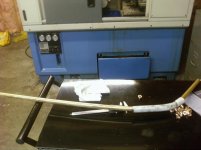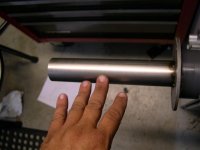Captdave
Titanium
- Joined
- Sep 24, 2006
- Location
- Atlanta, GA
I have heard stories of incidents where someone has left stock hanging out of the spindle and things going bad but never saw it happen until today.
Running a bushing job I have done several times in the past out of 3/4" brass in 4' sticks. The closest spindle liner I have is a 1" so I use a length of PVC which is real close to 3/4" ID and cap the RPM to 3500.
With 4' sticks and running real close to the chuck face to avoid waste leaves and tad over 6" outside of the spindle. Set the job up using a short piece to get it dialed in then loaded a full length bar. Boy did things get exciting quickly. Before I could hit the E-stop the whole bar came flying out of the machine Luckily I was still at the control and no one was near the machine when that thing came flying out and hit the ceiling.
Luckily I was still at the control and no one was near the machine when that thing came flying out and hit the ceiling.
Needless to say NOTHING OUTSIDE THE SPINDLE EVER AGAIN!
Where did I put Trusty Cook's number?
Running a bushing job I have done several times in the past out of 3/4" brass in 4' sticks. The closest spindle liner I have is a 1" so I use a length of PVC which is real close to 3/4" ID and cap the RPM to 3500.
With 4' sticks and running real close to the chuck face to avoid waste leaves and tad over 6" outside of the spindle. Set the job up using a short piece to get it dialed in then loaded a full length bar. Boy did things get exciting quickly. Before I could hit the E-stop the whole bar came flying out of the machine
 Luckily I was still at the control and no one was near the machine when that thing came flying out and hit the ceiling.
Luckily I was still at the control and no one was near the machine when that thing came flying out and hit the ceiling.Needless to say NOTHING OUTSIDE THE SPINDLE EVER AGAIN!
Where did I put Trusty Cook's number?










